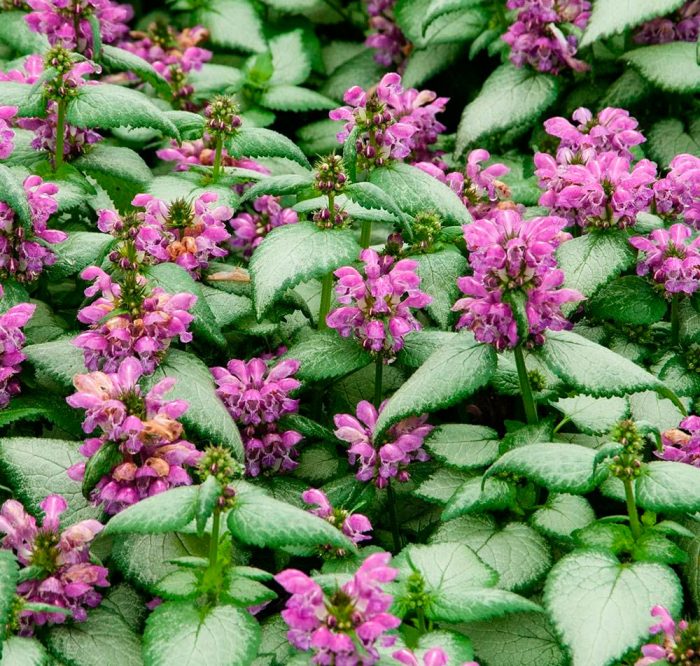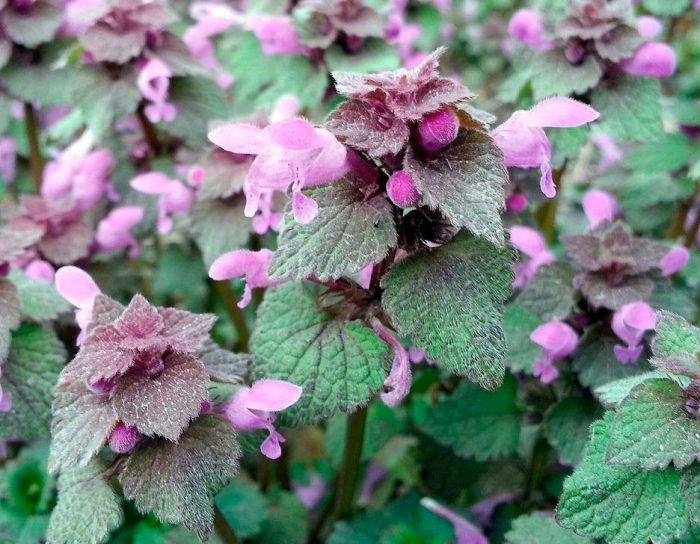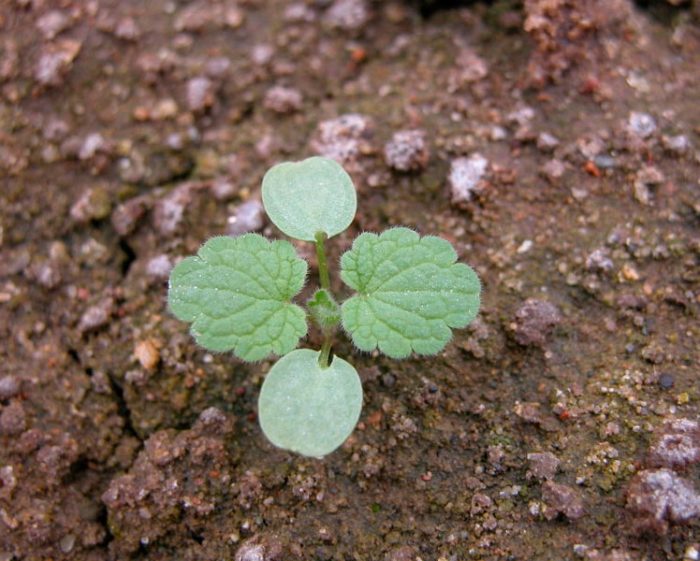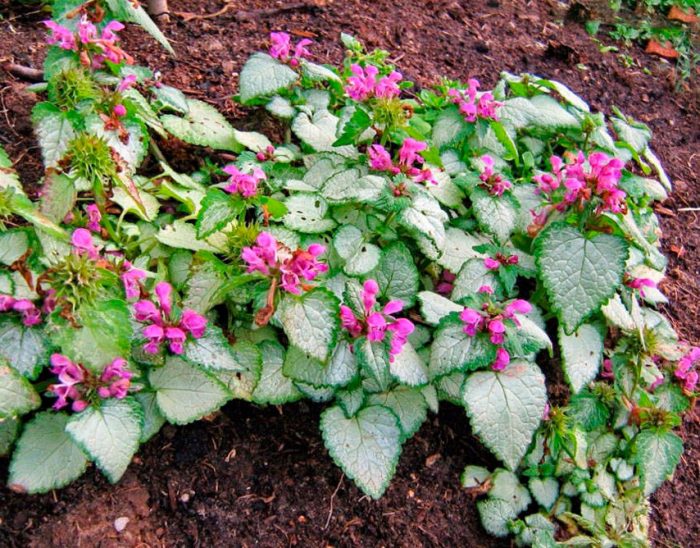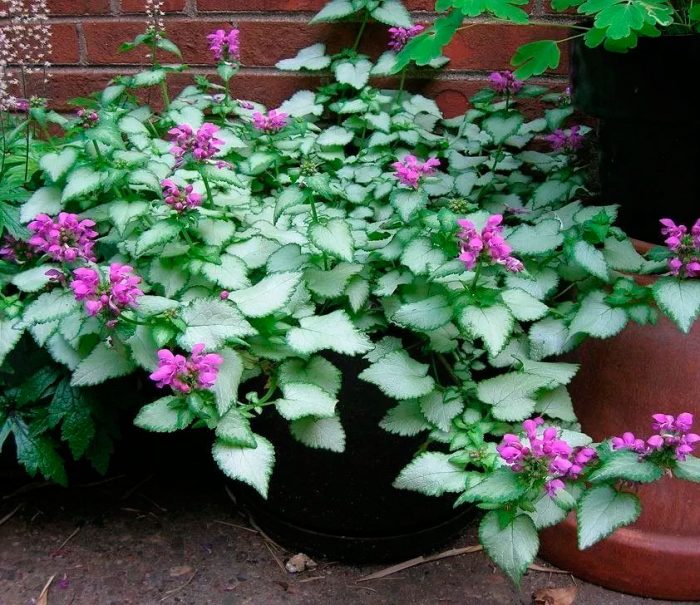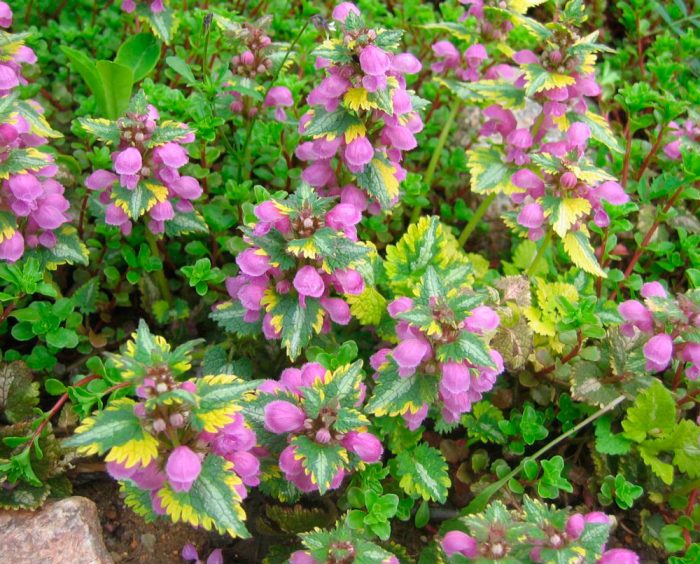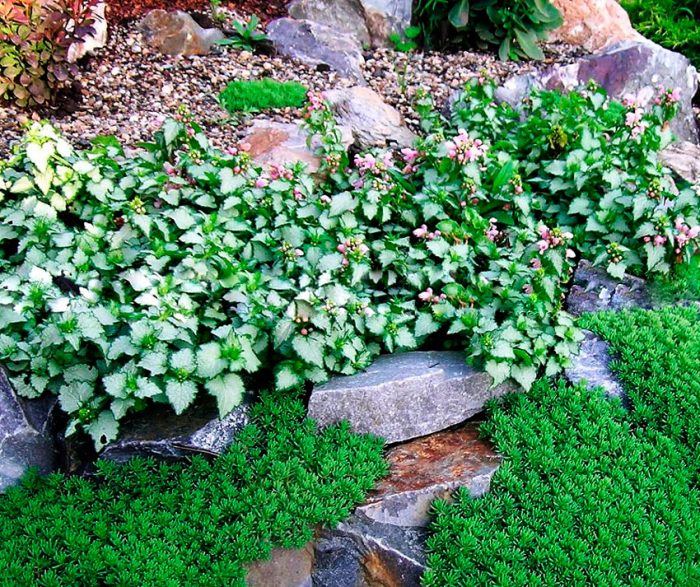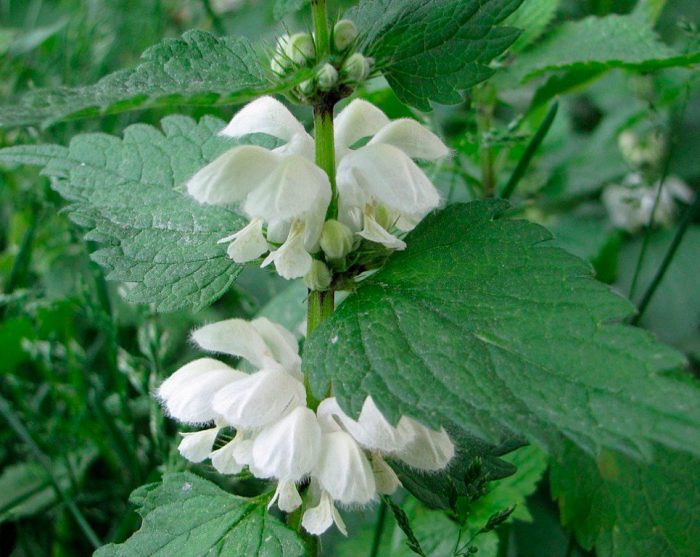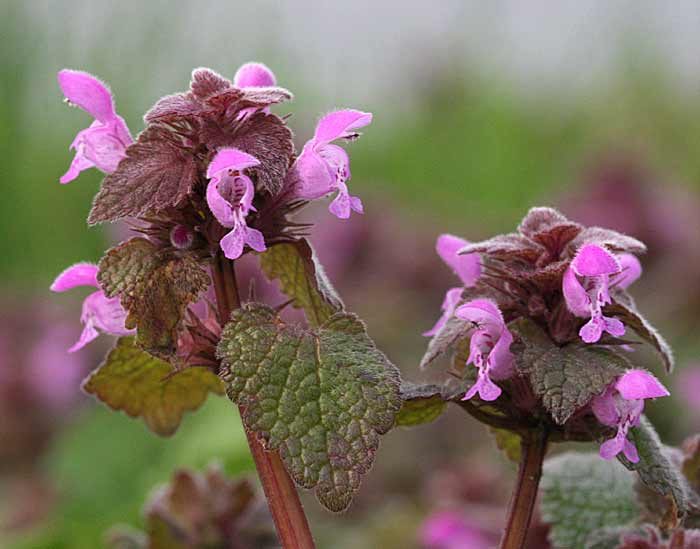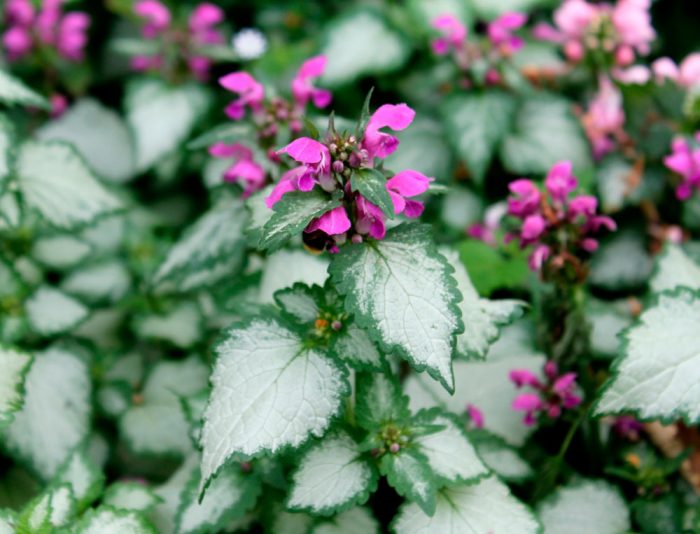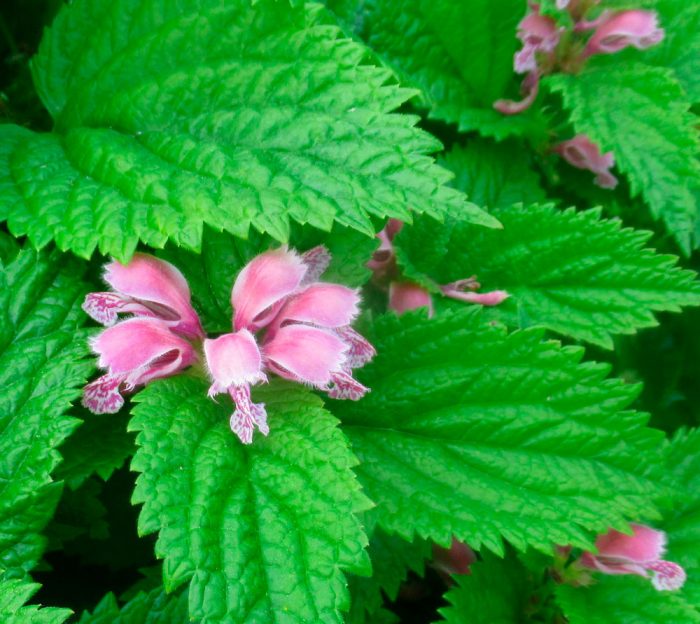The herbaceous perennial or annual plant Lamium is part of the Lamiaceae family. Under natural conditions, this plant can be found in Eastern Europe, while it prefers to grow along river banks. Outwardly, it looks like a simple stunted weed. But as a result of the work of breeders, various cultural ornamental varieties of the beetle were born, which can have a different color, height of stems and the shape of leaf plates. The shrub remains green and showy throughout the spring and summer. Low-growing varieties are cultivated as ornamental ground cover plants, while tall perennial varieties are used to decorate flower beds and flower beds.
Content
Features clear
The lamb is very fast growing, which makes it very similar to a simple weed. The maximum height of such a plant is about 0.25 m. Its root system is fibrous, therefore it can very quickly fill a vast area, decorating it with its branched stems. The dark green heart-shaped leaf plates have a serrated edge. In the center of the leaves, soft veins are clearly visible, in some cases the plate is decorated with spots.
Peduncles grow from internodes, while in length they can reach about 0.3 m. They are overgrown with small leaf plates and flowers. Flowers can be painted in different colors, they are double-lipped corollas. In the center of each flower there are thin stamens with purple-black anthers. Flowers are collected in whorls. After the whorl withers, a seed capsule is formed at this place, and there are triangular nuts in it. This seed pod is the fruit of the lamb. When the fruits are fully ripe, the seeds spill out of them themselves, due to which the plant reproduces well by self-sowing. The lamb blooms for a very long time for several months. The first flower buds are formed in the last spring weeks, and the beginning of the formation of fruits occurs at the end of June.
Growing from seeds
Sowing
Lamb is propagated by seeds. It is recommended to sow them in late autumn or at the beginning of the spring period, at which time the germination of seeds increases significantly.Seeds are sown not for seedlings, but directly into the garden.
Before you start sowing, you need to prepare the site. For this, the soil is dug up and all the weeds are removed. Level the surface of the soil in the area and distribute the seeds evenly. When the seedlings grow a little, they can be thinned out if necessary. It is quite simple to care for the seedlings, they only need to be watered moderately in a timely manner, if there has been no rain for a long time. Avoid overdrying the top layer of soil in the garden, but make sure that the liquid does not stagnate in the root system of the plants.
Most often, the lamb does not need weeding, because it itself can drown out the growth of weeds, while it covers the area with a solid carpet. However, perennial weeds, which have a very powerful root system, will have to be removed from the site.
Seed-propagated lamb blooms only in the second year after the seeds are sown. Experts advise not to allow uncontrolled self-seeding of this plant, because over time it can begin to suppress the development and growth of other crops growing in the garden and nearby. If you decide to plant different varieties of lamb, then choose areas for them located farther from each other. If they grow next to each other, then this can have a negative impact on their decorative effect, because after cross-pollination there will be no varietal differences between them.
Open field care
Illumination
Such a herbaceous perennial plant as a lamb is unpretentious to grow. For her, it is best to choose areas that are in the lace penumbra of tree crowns.
Priming
On the site, a suitable soil for growing such a flower should be moist and loose, it should contain a moderate amount of nutrients, including trace elements. If the soil is overly fertile, then this will lead to a rapid growth of the lamb, which can interfere with the normal growth and development of other flowering crops on the site.
Watering
Such a flower is watered systematically and abundantly, but make sure that the water does not stagnate in the root system for a long time. During the dry period, the foliage dries up and curls, and the shoots are still exposed. Shortly before flowering begins, the plant must be fed with organic matter.
Pruning
Like other ornamental ground cover plants, lamb should be systematically mown. If this is done in a timely manner, then the flower will be able to maintain its spectacular appearance, as well as bushiness.
Transfer
Adult bushes of perennial lamb is transplanted systematically, and they do it 1 time in 5 years. Such a plant is highly resistant to frost, so it does not need additional shelter for the winter.
Reproduction methods
Dividing the bush
Lamb can be easily propagated by dividing the bush. This method of reproduction among gardeners is very popular, because the bushes multiplied in this way fully retain their varietal qualities, and they bloom next year. It is recommended to divide the plant in the spring. To do this, carefully dig out the bush and divide it into several parts, while keeping in mind that on each division there must be root suckers that can give new shoots. After that, the delenki are planted in planting holes, which are prepared in advance. Don't forget to water them with plenty of water.
Layers
The propagation of lambs by layering is not very popular among gardeners. Most often, this procedure is carried out in the first autumn weeks. To do this, you need to choose the most powerful shoots, they are bent to the soil surface, fixed in this position and sprinkled with a not very thick layer of soil.Next spring, it will already be possible to separate and plant the layers that have taken root from the mother plant, since by this time they will be able to grow normally on their own.
Cuttings
The plant can be propagated by cuttings in the last summer days. To begin with, cuttings are harvested, which are planted for rooting in a mixture consisting of sand and peat. On top of them are covered with a cut plastic bottle or glass jar. Cuttings are provided with timely watering, and they must also be ventilated as soon as condensation appears on the surface of the shelter. When the roots grow from the cuttings, they can be planted in the garden in a permanent place. Rooted cuttings need a mandatory shelter for the winter, for this they are covered with spruce branches or foliage.
Diseases and pests
If you take care of the cleaver incorrectly and allow regular stagnation of moisture in the root system, this will lead to the appearance of rot on it. In this regard, special attention should be paid to the condition of the soil on the site, and also do not forget to water the plant correctly. All plants affected by rot are dug up and destroyed, and those areas on which they grew are treated with a fungicide solution.
Most often, the scabbard is harmed by the scale insect, spider mite and mealybug. To get rid of these pests, you will need to treat the bushes with a suitable pesticide.
Lamb in landscape design
Among gardeners, the most popular are variegated varieties of yarnotka. They are cultivated as an ornamental planting plant of free zones or grown in flower beds as separate decorative groups. This plant is best planted near host, lungwort and heuchera. Often, terraces, gazebos and balconies are decorated with clearness. They can also be grown as an ampelous plant.
Types and varieties of yasnotka with a photo
Today, there are about 25 species of such a garden perennial plant as the lamb. Below will be described those of them that are most popular with gardeners:
White lamb or dull nettle
In height, such a herbaceous perennial can reach about 0.45 m. The surface of shoots and foliage is rough to the touch. Oval-elongated leaf plates are painted in a greenish tint, their edge is serrated. They are attached to the shoot with short petioles. Flowering begins in June, and it ends only in the last days of September. The flowers are white.
Purple lamb, or red nettle
In the garden, this species is cultivated as a biennial or annual plant. Shoots length about 0.25 m, they are densely covered with very small oval leaf plates with a dark green color. The beginning of bud formation occurs in the middle of the spring period, but in general this plant blooms for several months.
Lamb spotted, or speckled
It is a tall, herbaceous plant with highly branching stems. The green foliage is adorned with silvery veins. Delicate pink flowers can be seen on the bushes during the flowering period from May to October. The best varieties:
- Album - color of flowers is snow-white;
- Beacon Silver - foliage is painted in an unusual silvery shade;
- Aureum - the color of the flowers is purple, and the foliage is yellow.
Green lamb, or yellow
Unlike other species, the creeping stems and foliage of this plant are pubescent. The shape of the leaf plates is elongated-oval, sometimes their surface is decorated with a marble mesh. The appearance of yellow flowers on the shoots is observed in the first days of May. Bushes can bloom again during the season. The best varieties:
- Argentatum - stripes are located on the surface of wide green leaf plates;
- Silver Carpet - oblong foliage is decorated with a silvery pattern.
Orval's lamb
During the flowering of this undersized plant, small rich pink flowers are formed on it.Duration of flowering is about 2 months (in May – June).
The healing properties of the lamb
Lamb is a medicinal plant. Its healing properties are due to the content of a large number of useful substances, while the most important of them are: alkaloids, flavonoids, essential oils, ascorbic acid and tannins.
Infusions based on this plant are used for sore throat, serious inflammation, or as a diuretic. In order for open wounds to heal faster, herbal lotions are applied to them. Hot baths with clear water help with gynecological diseases.
Before using lambda for the first time as a medicinal plant, it is recommended that you always consult with your doctor. There are practically no contraindications to the use of clearcoat. However, individual intolerance to the substances that make up the lamb is rarely found, which can cause the development of allergic reactions.
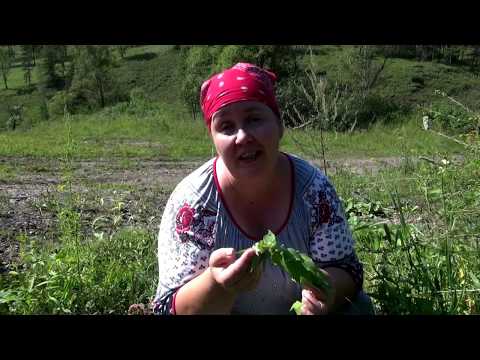

Watch this video on YouTube

